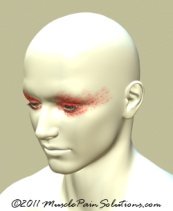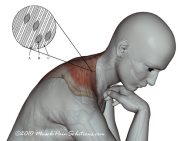Headache behind eyes — What a pain!

Headache behind the eyes is a common migraine symptom, though it can be a symptom of a tension headache as well. Although headaches in this area can be caused by other problems, the most common, and fortunately most treatable reason, is trigger points in certain neck and upper back muscles. A trigger point also sometimes known as a headache pressure point. (Click here to learn more about trigger points.) It is worth a shot to check these muscles and treat what you find to see if it will help you with your headache behind the eyes.
The following chart is a quick reminder for easy treatment of trigger points. For more complete info, check out the self massage page, or try the other method: Deep Stroking Massage.
Self Massage: Trigger Point Pressure Release |
|
Muscles that create Headache behind Eyes
These muscles are listed in the order of most common to least common cause of pain in this area. There are brief descriptions below with a link to an image of the muscle.
Sternocleidomastoid (SCM) — This is a very interesting muscle that can create a whole spectrum of problems, from dizziness and nausea, to ear ringing and head pain. The muscle has two branches — the sternal branch that runs from the skull behind the ear to the breast bone, and the clavicular branch that runs from the same place behind the ear underneath the sternal division to the collar bone. Only the sternal division creates headache behind eyes. The trigger points are located along the whole length of the muscle. For more complete info on this muscle, click here.
Temporalis Muscle — This is a flat muscle on the side of the head above the ear. It mostly creates pain in the side of the head, but can extend to the front of the head, behind the eyes. This muscle can even create tooth pain. The trigger point that refers behind the eyes is located about an inch or so back from the outside corner of the eye. These trigger points can be activated by clenching/grinding the jaw, dental work, excessive gum chewing and forward head posture. Click here for a picture.
Splenius cervicis — The trigger point that creates headache behind eye is located close to the spine about halfway down the neck. This muscles is irritated by bending your head forward for long periods of time (such as studying, reading, and writing). A tool like an Easy Reader that props your book up can reduce the strain on these muscles. Click here for a picture.
Masseter muscle — This muscle is the main chewing muscle, and starts right under your cheek bone, and ends covering the angle of your jaw. It is the one you will feel pop out right in front of your ear when you clench your jaw. It is irritated by clenching your jaw, chewing gum, ice, and nails, as well as dental work. In addition to creating pain above the eyes, it also creates jaw pain, facial pain, tooth pain and sensitivity to heat and cold. It can also act like a sinus problem with sinus pain and drainage and stuffiness. It can also create deep ear pain, itch, or even a low roar in the ears. To treat these muscles, put your thumb inside your mouth outside your teeth and fingers outside and pinch. If you need it, it will hurt like crazy, but be patient and persistent with this and you will get relief from your symptoms. Click here for a picture.
Suboccipital muscles — These are a set of very small muscles at the base of the skull. You can find them by poking right below the edge of the skull from behind the ear, all the way to the other side. They very frequently create headache behind eyes, but they also refer pain to the side of the head, behind the ear, and also can create pain at the base of the skull. They are stressed by activities that require you to extend your head or look up. This can happen when someone lies face down on the floor and then props their neck up their hands to watch TV. It can also happen with poorly adjusted bifocals. Click here for a picture of these muscles.
Occipitalis — This is a flat muscle that is actually on the skull itself and refers pain to the back of the head and the eye. To find it, poke the back of your skull. If these muscles are really "upset" you might notice it is painful to lay your head on a pillow. It can also entrap a nerve that runs through it and then can create a hot prickling and tingling sensation in the back of your head. Trigger points can be created by stress and tension tightening your face, wrinkling of the forehead and vision problems causing squinting. Click here for a picture.
Obicularis oculi — This is an odd muscle that makes a ring around your eye, and helps you close your eye and squint. Trigger points are usually created by tension and eye strain, or poor eye sight. In addition to creating eye pain, trigger points in this muscle can make your eye eyelid droop, your eye twitch, and even the print to "jump" on the page. You can gently push on this muscle, but usually these trigger points are secondary to the SCM (see above). Click here for a picture.
Trapezius — This large muscle, called trapezius for it's shape, is very complex and has a number of trigger points. Trigger point #1 is located right where the neck meets the shoulder. Pinch the small roll of skin right where the shoulder joins the neck. It feels like a tight band and sends pain to the temples, angle of the jaw, down the neck behind the ear, deep behind the eye, and to the back of the head. For a picture of this trigger point, click here.
Check out the Headache page to find out more about what type of headache you have and get more tips on reducing or eliminating the annoying headache behind eyes.




